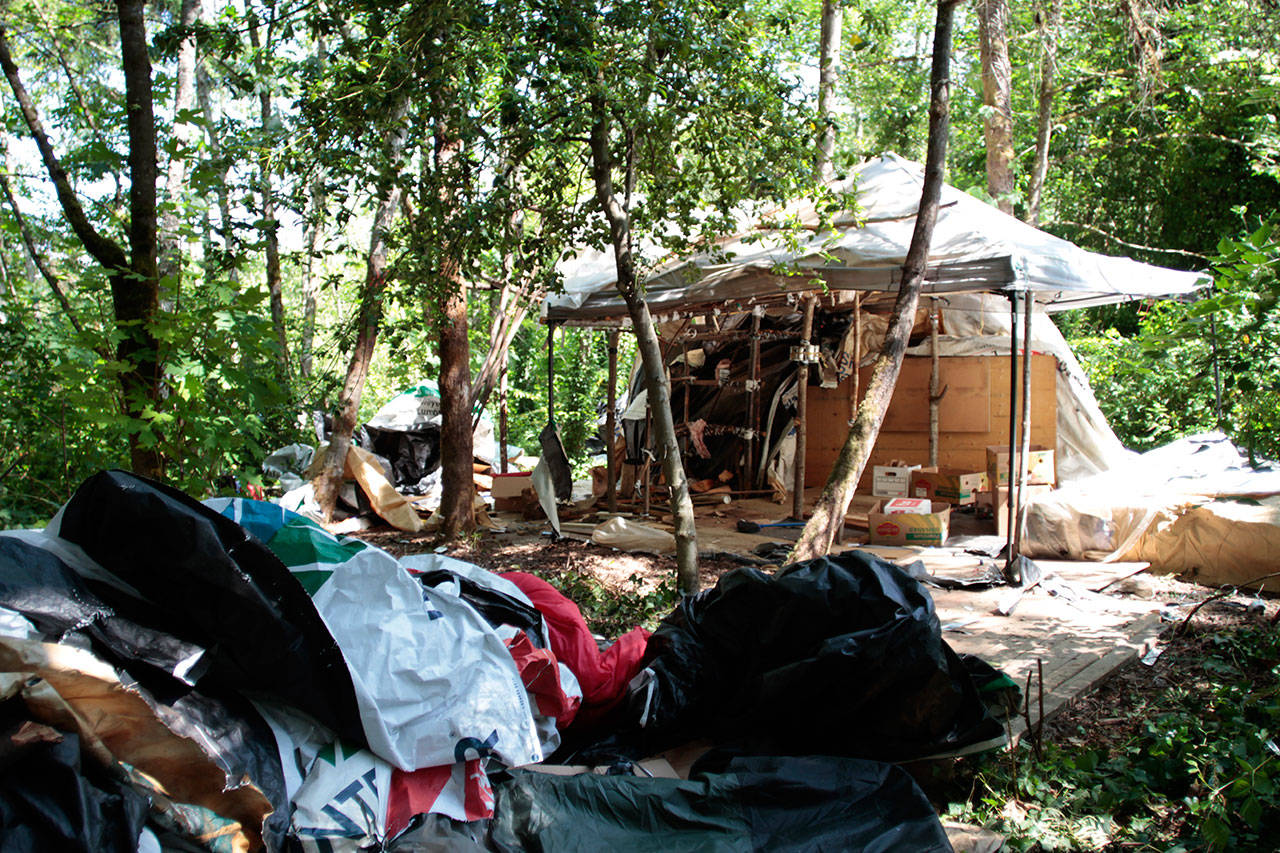It was the end of an era — a conspicuous, complicated, controversial era — this week, as Bainbridge Island police began clearing away the final vestiges of the homeless camp next to Highway 305 at High School Road, and the two remaining residents were relocated to more permanent housing.
The large and obviously visible campsite, which was actually two distinct encampments, on the west side of Highway 305 and High School Road had been the subject of community concern for some time, as well as the source of multiple 911 calls to police and firefighters.
It was very gratifying, said Bainbridge Island Police Department Sgt. Ben Sias, who led a combined effort of multiple agencies to remove the illegal campsite.
“It was a source of a whole lot of complaints and it was a bad situation for two of our citizens to be in, so I’m glad it’s over,” Sias said.
Police initially cleaned up the smaller of the two encampments in early March after they discovered the men living there had received alternative housing. They removed tents, bedding, trash, tarps, firewood and other castaway debris to the side of the highway, where a large shipping container was waiting to take it all away.
Occupants had earlier told the Review that their campsite had existed alongside Highway 305 for years undetected, but people began noticing their tents — and started complaining — after two newly homeless islanders put up a larger campsite a few dozen yards north in the woods on the same side of the highway.
That encampment, home to two, an elderly woman and her adult son who had previously been kicked out of the Rhododendron Apartments, had also been a magnet for police and fire department visits, as well as public attention throughout the past year, before finally being removed this week.
It was much more visible to passersby on Highway 305 than its better camouflaged former neighbor to the south, and included a large tent with a stovepipe-style heating exhaust pipe popping out of the top that sent conspicuous smoke wafting toward the highway on cold days. Nearby stood a tall radio antenna, hoisted by one of the residents.
“Most of it’s gone; it had a wood stove and a bunch of other stuff, it was pretty expansive,” Sias said. “I talked to the Department of Transportation [Tuesday] and they said that in the next couple days they were going send a dump truck out to get the rest of it out.”
The mother and son had not been offered housing along with their former neighbors from the other homeless campsite, Sias said, because of problems and concerns arising from the son’s behavior.
“Nothing was offered to them because of his reputation, and because they had what amounted to an eviction, they didn’t get their lease renewed at Rhododendron Apartments because of the [son],” Sias said. “There were concerns. Unlike other homeless camps, there wasn’t any drug or alcohol issues, but clearly there are some mental issues and there was a concern about his unpredictable behavior. And it was a stipulation of the agreement that the resources who had come together to form this team to obtain housing will continue to commit to interactions, visits, keeping the people on track so the cycle doesn’t repeat itself.”
The resources involved in the resolution were surprisingly numerous, Sias said.
“It took a real effort [because] it’s really hard to find housing, especially with an eviction on your record,” he explained. “A group of different agencies came together. It was, to a very minor extent, Adult Protective [Services]. They were involved because of his elderly mother, and they went to one of our meetings but haven’t been involved since then. But a lot of it was the Housing Resources [Bainbridge] board and Cross Sound Church, and Helpline and me.”
The couple were moved into an apartment on Bainbridge Island Monday, which was the best possible outcome according to Sias.
“We faced the possibility of them just being moved and not addressing the root problem of them being homeless,” he said. “So we were able to use that to get a little bit more time with the Department of Transportation, and fortunately we were able to get them housing as opposed to just moving [them] and then cleaning it out or doing a sweep or anything like that.
“We didn’t just displace the problem; we got them actual housing and I hope they can hold it together. I committed to checking in with them every work week so I’m going to keep after it.”
Sias said it was important to the island police, and to him personally, to see the troubling situation resolved this way.
“It’s just part of our community caretaking role,” he said. “A lot of the things that we get involved in aren’t necessarily specific to law enforcement, but they’re for the betterment of the community. And we also have an obligation, not only for the people that were living there, but to address the concerns of the other citizens on the island who are upset about a homeless camp going in, and especially one that’s so obvious and huge and white with a chimney.”
The area immediately to the side of the highway, technically the responsibility of the Department of Transportation, is now posted with official No Camping signs and island police have committed to regularly monitoring the area and rousting any squatters.
“It wasn’t posted and I got a hold of Department of Transportation who owns the property and I had them post the signs there at about the time that the first homeless camp was removed, after they got housing,” Sias said.
“It will be enforced from now on.”


